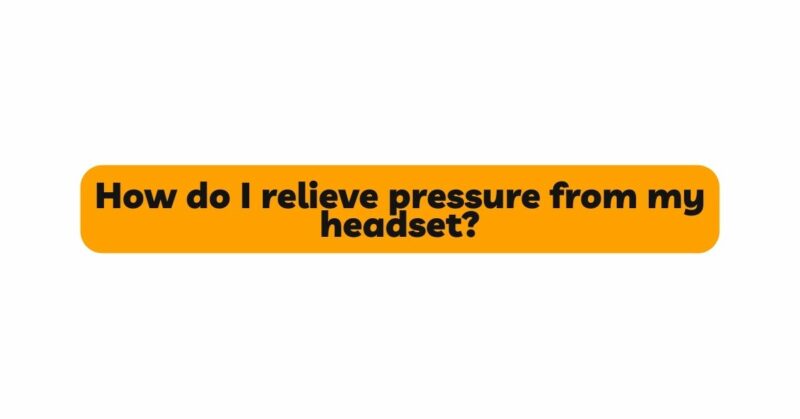Headsets have become indispensable tools for modern communication, enabling us to engage in clear and convenient conversations in various settings. However, extended use of headsets can sometimes lead to discomfort and a sensation of pressure on the head, ears, and jaw. This pressure can cause discomfort, headaches, and even affect overall well-being. In this comprehensive article, we will explore the reasons behind the pressure caused by headsets and provide a range of practical techniques to relieve the discomfort and make your headset experience more enjoyable and comfortable.
Understanding Headset Pressure: The Anatomy of Discomfort
Before diving into the methods of relieving headset pressure, it is essential to understand the factors contributing to this discomfort. Headset pressure can manifest in various ways, such as:
- Ear Pressure: The ear cups of over-ear headsets may exert pressure on the ears, leading to a feeling of tightness or discomfort.
- Temporal Pressure: On-ear and over-ear headsets often create pressure on the temporal regions of the head, where the headband rests, causing tension and discomfort.
- Jaw Pressure: Extended periods of headset use can lead to jaw fatigue and discomfort, especially in headsets with tight headbands or when the jaw is kept tense during conversations.
- Headband Pressure: The headband of the headset, if too tight or lacking sufficient padding, can cause pressure points on the top of the head.
- Ear Pad Design: The material and design of the ear pads play a significant role in determining comfort levels. Low-quality or poorly designed ear pads can exacerbate pressure on the ears.
Now, let’s explore practical techniques to relieve pressure from headsets and enhance your overall comfort.
Techniques to Relieve Pressure from Headsets
- Choose the Right Headset
Selecting the right headset can significantly impact comfort levels. Consider the following factors when choosing a headset:
a. Headband Adjustability: Opt for headsets with adjustable headbands to fit your head size comfortably. This helps distribute the pressure evenly and reduces discomfort.
b. Ear Pad Material: Look for headsets with soft and breathable ear pad materials, such as memory foam or velour, that provide better airflow and reduce pressure on the ears.
c. Open-Back Headsets: Open-back headsets allow for better ventilation and help reduce pressure build-up inside the ear cups.
d. Lightweight Design: Headsets made with lightweight materials put less strain on your head and reduce overall pressure.
- Adjust Headset Position
Properly adjusting the position of the headset can alleviate pressure points. Ensure the ear cups sit comfortably over your ears, not pressing too tightly, and the headband rests securely on your head without exerting excessive force.
- Take Regular Breaks
Prolonged use of headsets can lead to discomfort and pressure. Schedule regular breaks during extended headset use to give your ears, head, and jaw a chance to relax and recover.
- Use Headset with Inline Controls
Headsets with inline controls allow you to adjust volume and microphone settings conveniently without reaching for external devices. This minimizes unnecessary movements and reduces jaw tension.
- Optimize Microphone Placement
Position the microphone of your headset at an appropriate distance from your mouth. Keeping it too close can strain your jaw muscles, while keeping it too far may cause you to speak louder, creating unnecessary pressure.
- Loosen Headset Fit
If you feel excessive pressure, consider slightly loosening the headband or readjusting the ear cups to reduce tension on your head and ears.
- Practice Jaw Relaxation Exercises
Regularly perform jaw relaxation exercises to release tension and ease discomfort caused by prolonged headset use.
- Use Ear Pads with Cooling Properties
Consider using ear pads with cooling gel or materials that wick away moisture. This can prevent discomfort caused by heat and sweating during prolonged use.
- Apply Warm Compresses
If you experience tension or soreness around your ears and head, applying a warm compress can help soothe muscles and alleviate discomfort.
- Try Neck Stretches
Perform neck stretches to release tension in the neck and shoulder area, which can contribute to headset discomfort.
- Maintain Good Posture
Maintaining good posture while using headsets can help prevent tension in the neck and shoulder muscles, reducing the likelihood of discomfort.
- Use Noise-Canceling Headsets
Noise-canceling headsets can reduce the need to increase volume levels in noisy environments, minimizing pressure on your ears and head.
- Use a Headset with Rotating Ear Cups
Headsets with rotating ear cups allow you to wear them around your neck when not in use, relieving pressure from your ears temporarily.
- Consider Bone Conduction Headsets
Bone conduction headsets transmit sound through vibrations directly to the inner ear, bypassing the eardrums. These headsets can alleviate ear pressure for individuals sensitive to traditional ear cup designs.
Conclusion
Pressure from headsets can be an uncomfortable and distracting experience, but with the right techniques and considerations, it is possible to alleviate the discomfort and enjoy clear communication without strain. By choosing the right headset with proper adjustability and materials, taking regular breaks, and incorporating relaxation exercises, you can enhance your overall headset experience and promote better ear and head health. Remember, it is essential to prioritize comfort and well-being during extended headset use to ensure a seamless and pleasant communication experience. Happy chatting!


